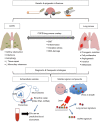Chronic obstructive pulmonary disease (COPD) and lung cancer: common pathways for pathogenesis
- PMID: 31737343
- PMCID: PMC6831920
- DOI: 10.21037/jtd.2019.10.54
Chronic obstructive pulmonary disease (COPD) and lung cancer: common pathways for pathogenesis
Abstract
Chronic obstructive pulmonary disease (COPD) and lung cancer comprise the leading causes of lung disease-related mortality worldwide. Exposure to tobacco smoke is a mutual aetiology underlying the two diseases, accounting for almost 90% of cases. There is accumulating evidence supporting the role of immune dysfunction, the lung microbiome, extracellular vesicles and underlying genetic susceptibility in the development of COPD and lung cancer. Further, epigenetic factors, involving DNA methylation and microRNA expression, have been implicated in both diseases. Chronic inflammation is a key feature of COPD and could be a potential driver of lung cancer development. Using next generation technologies, further studies investigating the genomics, epigenetics and gene-environment interaction in key molecular pathways will continue to elucidate the pathogenic mechanisms underlying the development of COPD and lung cancer, and contribute to the development of novel diagnostic and prognostic tools for early intervention and personalised therapeutic strategies.
Keywords: Pulmonary disease; chronic obstructive; lung neoplasms.
2019 Journal of Thoracic Disease. All rights reserved.
Conflict of interest statement
Conflicts of Interest: The authors have no conflicts of interest to declare.
Figures

References
-
- GOLD. Global Strategy for the Diagnosis, Management, and Prevention of Chronic Obstructive Pulmonary Disease - 2018 Report. 2018. Available online: http://goldcopd.org/wp-content/uploads/2017/11/GOLD-2018-v6.0-FINAL-revi...
-
- Lung foundation Australia. Economic impact of COPD. 2008. Available online: http://lungfoundation.com.au/health-professionals/clinical-resources/pub...
-
- WHO. COPD predicted to be third leading cause of death in 2030. 2008. Available online: http://www.who.int/respiratory/copd/World_Health_Statistics_2008/en/
Publication types
LinkOut - more resources
Full Text Sources
Other Literature Sources
